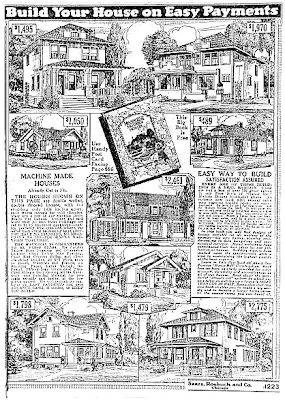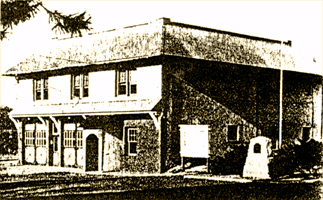"Places"
For a town that is about three miles from North to South and a mile or a mile and a half from East to West, there were many places that could capture the interest of a young boy with an adventuresome (and snoopy) nature such as myself. |
| The Kessler/Conlin Estate |
Kessler/Conlin Estate
There were several estates throughout the town that surely should not go without being recognized. The largest and most impressive of those being The Kessler/Conlin Estate. This was a huge three story wood frame house on the site of the present Edgewood Country Club.The house was constructed by Julius Kessler, who was one of the first mayors of River Vale and the owner of the Kessler Whiskey Distillery. The estate covered over 300 acres and at one time had many "wild" non-native animals wandering throughout the fields and wooded areas of the estate.
Sometime during the 30s the place changed ownership from Kessler to a Mr. and Mrs. Ben Conlin. Mrs. Conlin was Mr. Kesslers niece, Dorothy Brady Conlin. About the year 1944, my friend Bob Castello and I became friendly with Don Conlin, the son of the Conlins and we spent every day of our summer vacations at the estate. For two young fellows who hardly got out of the boundaries of the Pascack Valley, this was something that really had us in awe. The major rooms in the house were huge with ceilings that I would guess were 12 feet high. As you moved through the heavily carpeted rooms, you had the feeling that you could easily have been in the company of New York's finest social set, who also spent many hours being entertained in the very same rooms. There was even a "card room" all done in natural wood, possibly a teakwood or something similar. Each and every room in that house just smacked of elegance. It could have been from a Hollywood movie set like "Gone With The Wind" or something of that sort. There was an indoor swimming pool (unheard of in those days), a pool room, a bowling alley, a separate maid's quarters, a kitchen that could have come from a small New York City hotel, that elegant card room that I mentioned previously, and best of all was the hospitality and charm that Mrs. Conlin offered to these two local urchins.
As soon as you would turn off River Vale Road and go into that driveway with the huge pines overhanging the driveway and parking areas you would have thought that you were someplace far from River Vale. The outer areas of the estate were maintained by a Mr. Albert Miller from River Vale who worked for the Conlin family. The inside of the house was managed by a very charming and cheerful Japanese lady, who was relocated in the East from California, against her wishes, by the U.S. Government during the early days of the war. As I remember, Irene was born in Japan, but came here as an infant and was considered a "threat" to our country and thus shipped East. Irene was a dear person who always kept us supplied with cookies, wonderful sandwiches and ice tea during the summer months.
The entire estate was sold to John Handwerg (the golf course builder) in the late 40's and soon became a 27 hole golf course. John Jr. moved into the big frame house and remained there until about 1950 when the beautiful house burned to the ground. A very sad day for all of us who knew the place as we did. One somewhat interesting sidelight of this fire was told to me by John Handwerg himself. On the night of the fire when the Handwerg family was sound asleep they were awakened by a loud clanging bell. This enabled the entire family to get out of the house alive. But what was that bell? It seems as though Julius Kessler had a big fire alarm system installed in the house probably prior to World War I. No one even knew of the system until the firemen went thru the ruins and discovered the thing in the cellar. When the time came the thing did exactly the job that it was supposed to do.












